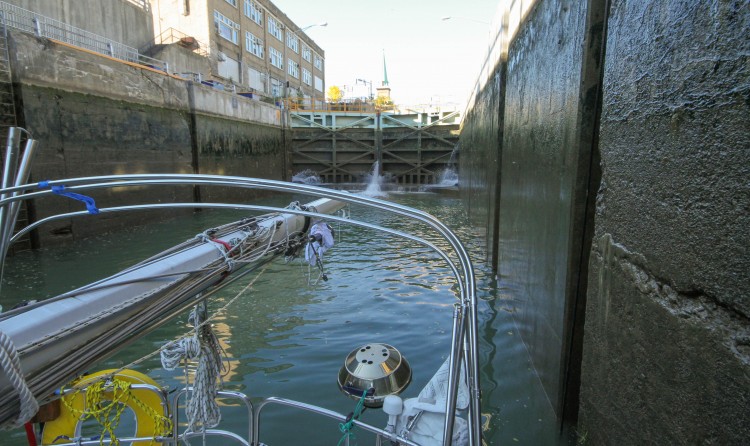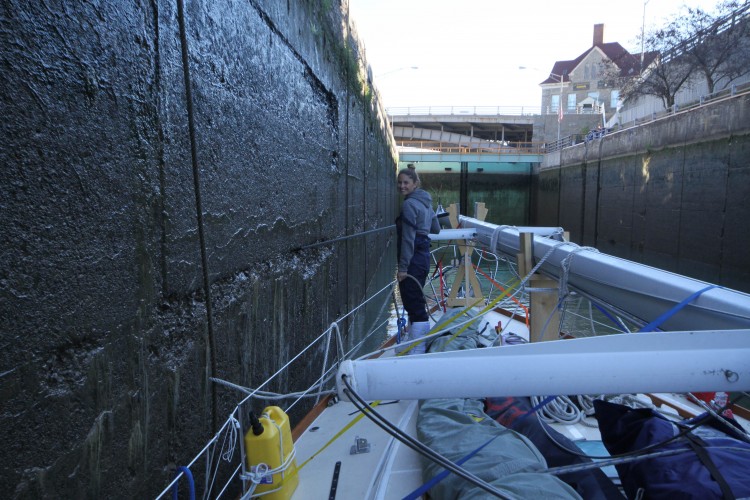 We’ve now transitted 35 locks of the New York State Canal System, through the Erie Canal from Buffalo to Albany, NY, and frankly we are quite happy to be done with elevation change for a while.
We’ve now transitted 35 locks of the New York State Canal System, through the Erie Canal from Buffalo to Albany, NY, and frankly we are quite happy to be done with elevation change for a while. Why are we so relieved to be out? Because going through locks is tiring, tedious and dangerous (more so than we originally thought). Effectively, your boat (along with a few others) will enter a cement chamber ~300 feet long x ~45 feet wide, with gates at either end that close you in, like a caged wild animal. And like a caged animal, your sailboat will not happily sit still in the cage, but rather squirm around as the Lockmaster lets the water in or out, and you will try to hold it in place with boat hooks and the slimy, wet ropes that are attached to the cement walls (you’re going to want to watch out for the aqua spiders that hide on them too, too). During this process, you try not to scrape or slime your boat and also avoid hitting the multi-million dollar power yachts beside you as the water swirls around. It’s stressful, don’t let my smile fool you.
Why are we so relieved to be out? Because going through locks is tiring, tedious and dangerous (more so than we originally thought). Effectively, your boat (along with a few others) will enter a cement chamber ~300 feet long x ~45 feet wide, with gates at either end that close you in, like a caged wild animal. And like a caged animal, your sailboat will not happily sit still in the cage, but rather squirm around as the Lockmaster lets the water in or out, and you will try to hold it in place with boat hooks and the slimy, wet ropes that are attached to the cement walls (you’re going to want to watch out for the aqua spiders that hide on them too, too). During this process, you try not to scrape or slime your boat and also avoid hitting the multi-million dollar power yachts beside you as the water swirls around. It’s stressful, don’t let my smile fool you. We are happy to say we avoided any collisions or scrapes, but for anyone else planning a similar voyage, here are our 5 top tips for lock success:
We are happy to say we avoided any collisions or scrapes, but for anyone else planning a similar voyage, here are our 5 top tips for lock success:
5) Have a plan for how your boat can pull up nicely parallel to a very tall (or very short, depending on which way the water is going) cement wall. Some power boats have bow-thrusters that do this for them very nicely, but we just used our one propellor (and its prop walk) and a very carefully timed slow down, docking technique with boat hooks, fenders and lines. We watched some entertaining docking events go down in locks among crews who had not planned how they were going to get alongside the wall (short story – lots of swearing, some mild boat/wall smashing, maybe some tears).
4) Have the right equipment for protecting your boat. We used lots of fenders, and a DIY fender board for this. Having some old lines that you don’t mind getting slimed from the walls are great too, as sometimes there are fixed lines or cables (versus attached at the top but free swinging below) and you can loop a line around these to hold yourself in place. Just be careful not to get them caught as your boat is going up or down (same for your fenderboard!) or you’ll have a bad time.
3) Have the right equipment for your crew, which for us meant work gloves and boat hooks (or any sturdy long stick used to push off the wall). The ropes that you grab onto spend most of their lives sitting in swamp water, growing all sorts of new slime forms and just waiting to slip out of your hands. They’re disgusting, and you definitely don’t want to bite your nails after handling them.
2) Slow down when entering the lock. There is a finite “runway” to these “landing strips” of cement, and you do not want to slam into the boat in front of you, or the metal gates at the other end. Also, we’re learning very quickly that a 40 foot boat keeps a lot more momentum than the 27 footer we’re used to, and it’s not easy or safe to try and manually slow these boats down without a cleat (there are lots of rings, but these take an additional couple of seconds to thread a line through). Although Mark has now nearly mastered our clockwise prop walk, it can be a bit unnerving to see your stern moving towards the boat tied beside you as you back up.
1) Pay careful attention while descending or ascending. CONSTANT VIGILANCE. Or you’ll hit your boat against the wall / your boat against someone else’s boat. Since our boat is shaped like an almond and not like a rectangle (looking at you, house boats of the Erie Canal), we don’t have one nice long flat surface to line up against a wall, but instead will swing as the water swirls around us, unless we are in a constant state of push and pull to keep ourselves straight.
We loved the scenery, people and free docks we’ve encountered along the Erie Canal…but we are very happy to be heading out of our landlocked waterway and onto the Hudson River.
